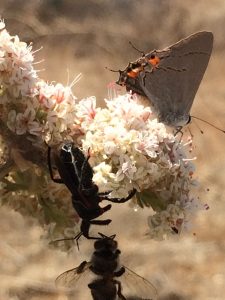Alicia Di Rado is the winner of the August ‘Where in the Conejo’ photo contest!

The August 1 “Where in the Conejo” contest photo featured a hairstreak butterfly feeding on buckwheat flowers while a bee assassin captured a honeybee. Of the correct entrants, Alicia Di Rado was selected at random as the winner of a $25 gift certificate. Congratulations, Alicia, and thanks to all who entered!
Although it may appear that the three insects’ activities are related, it’s unlikely the gray hairstreak butterfly is aware of the lurking bee assassin. The hairstreak is in the family of small gossamer-winged butterflies, which also includes the marine blue—one of the possible answers offered.
The bee assassin is an ambush hunter and will hide in flowers—in this case, native buckwheat—waiting for a bee to arrive. The bee assassin’s sticky foreleg hairs trap the bee as it lands. While it looks somewhat similar to a skunk beetle (aka stink bug), bee assassins can fly and skunk beetles, which are scavengers and not predators, can’t.
The bee assassin uses its mouthparts, called a beak, to first inject saliva and then suck the liquified innards out of its unlucky victim. Experts think it is unlikely that there are enough bee assassins to have a significant impact on honeybee populations. Bee assassins may bite humans defensively if they are handled roughly.



0 Comments